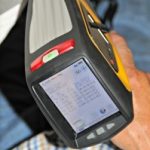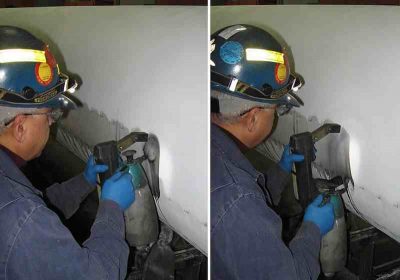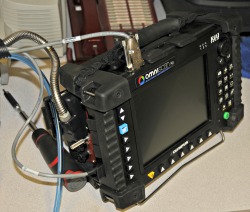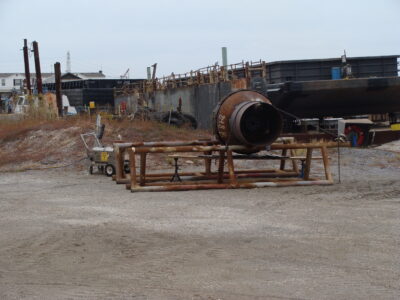Non-Destructive Testing in Harvey, LA

Trust our team with quality non-destructive examination, also referred to as non-destructive testing, in Harvey, LA. SOUTHERN INSPECTION & TESTING offers cutting-edge equipment and techniques to gather material and information effectively. We provide analysis and methods to evaluate materials’ and components’ properties within an established system or structure that causes no permanent alteration.
Contact our specialists to learn more about the following services:
Dye Penetrant
Liquid dye penetrant determines failures and imperfections in non-porous materials, such as metals, plastics, and ceramics. This method is usually called dye penetrant inspection (DPI), liquid penetrant inspection (LPI), or penetrant testing (PT) and consists of a simple, cost-effective process. First, the materials to be tested are cleaned and then coated with a dye solution, either visible or fluorescent. A developer is then applied to highlight flaws in the material that cannot be seen through visual inspections.
Hardness Testing
Hardness testing determines a metal’s strength, ensuring it meets industry standards and project requirements. As a leading construction testing company, we pay great attention to structure preparation and sample extraction. All incoming samples undergo various tests—including the Vicker, Rockwell, and Brinell methods—conducted in a controlled environment to preserve the metal’s integrity.
Magnetic Particle
 We also specialize in magnetic particle inspections, a non-destructive testing method that detects discontinuities on the surface and sub-surface of ferroelectric materials, such as iron, cobalt, and nickel. These alloys undergo magnetic particle inspection, which utilizes the magnetic flux of ferrous iron particles to identify discontinuities.
We also specialize in magnetic particle inspections, a non-destructive testing method that detects discontinuities on the surface and sub-surface of ferroelectric materials, such as iron, cobalt, and nickel. These alloys undergo magnetic particle inspection, which utilizes the magnetic flux of ferrous iron particles to identify discontinuities.
Positive Material Identification
Positive material identification ensures proper material selection, identifying corrosion resistance while complying with codes and industry standards. Our specialists use this measure to determine alloy composition and provide a material fingerprint on top-notch mobile testing equipment.
Ultrasonic Testing
We proudly offer ultrasonic testing using high-frequency sound energy to collect material information from steel, concrete, wood, and composites. With this technology, we detect material flows, measurements, dimensions, and characteristics without altering an existing structure or project.
Phased Array Ultrasonic Testing
 We also specialize in phased array testing, an electronic method to generate, receive, and display ultrasound signals. Our construction testing company is equipped with resources to measure a material’s thickness, do welding inspections, and measure manual UT-shear waves. This process is usually used for power plants, utility facilities, refineries, petrochemical plants, and transmission towers, which is why the structures must meet industry codes. Our team will detect any defects in the structure surface and sub-surface caused by fatigue, corrosion, or wear.
We also specialize in phased array testing, an electronic method to generate, receive, and display ultrasound signals. Our construction testing company is equipped with resources to measure a material’s thickness, do welding inspections, and measure manual UT-shear waves. This process is usually used for power plants, utility facilities, refineries, petrochemical plants, and transmission towers, which is why the structures must meet industry codes. Our team will detect any defects in the structure surface and sub-surface caused by fatigue, corrosion, or wear.
X-Ray/Radiographic Testing 
Another type of non-destructive testing mechanism is the X-ray method. Radiographic testing (RT), or industrial radiography, looks for hidden flaws using short-wavelength electromagnetic radiation to penetrate various materials. We provide this service on-site or in our facility, depending on what is more convenient for our customers. Our mobile units are equipped with information processing to complete this field testing and provide immediate results.
Our customers can also request an initial visual material inspection on-site or in the field. With our industry knowledge and experience, we offer proper identification of material conditions adhering to non-destructive testing standards. If our specialists identify complex issues requiring further testing, we immediately report it to our clients.
Borescope Testing
Borescope testing visually inspects an inaccessible area to recognize defects and imperfections. It detects damage related to heat, erosion, corrosion, and cracking, allowing our team to report it to our customers immediately. The industries commonly using this test include aircraft, plants, and automotive.
Leak Testing
As an experienced construction testing company, we provide on-site services for leak testing applications in many environments. Our team supports small to large construction projects, ongoing maintenance, welding fabrication facilities, and one-time applications, as well as laboratory testing services at our facility.
With our licenses and certifications, our staff performs leak location, quantified leakage measurement testing, and custom testing procedures. Testing is completed in accordance with ASTM standards, ASME Boiler and Pressure Vessel Code, API Code, and ANSI N14.5 standards. Our technicians are also Level I, II, and III certified with ASNT-TC-1A, ANSI/ANST CP-189, and NAS-410. During their training, they completed 80 hours of classroom time and four years of leak testing experience, qualifying them in the following methods:
- Helium Mass Spectrometer
- Pressure Change/Measurement
- Ultrasonic
- Thermal Conductivity
- Bubble
- Halogen Diode
Thermography
Infrared imaging science includes infrared thermography (IRT), thermal imaging, and thermal video. These thermographic cameras detect radiation in the infrared range of the electromagnetic spectrum to produce images called thermograms. Thermography allows us to see our surroundings with or without visible light by detecting the infrared radiation emitted by objects above absolute zero. The radiation in an object increases with temperature, allowing thermography to see variations during the non-destructive testing.
Video Inspection
 Our construction testing company specializes in video inspections and other NDTs for various industries. Whether commercial or industrial, our experts are experienced in different applications and provide custom solutions for small to large projects. Contact our team to learn more about our testing services!
Our construction testing company specializes in video inspections and other NDTs for various industries. Whether commercial or industrial, our experts are experienced in different applications and provide custom solutions for small to large projects. Contact our team to learn more about our testing services!
